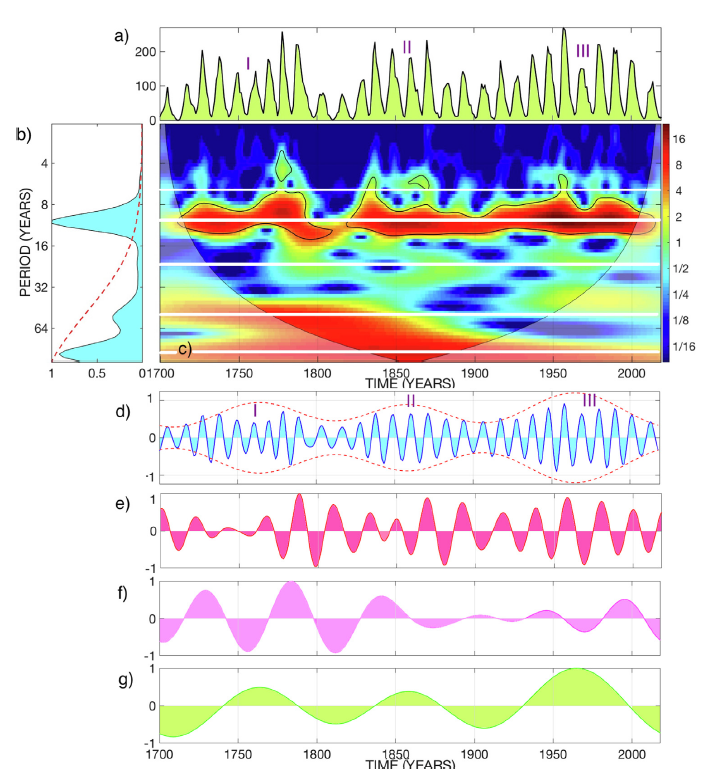Analyzing the cyclic nature of solar activity, leading scientists suggest a solar minimum is set to persist until 2050.
It’s important to estimate the features of the next solar cycle because they serve to improve preparedness in space exploration and minimizing risks in technological and sociological activities.
The ability to understand historical solar magnetic parameters more accurately, beyond the highly dominant 11-year cycle, is a key to estimating solar variability, researchers say. Moreover, a number of scientists believe there is a clear link between solar activity and climatic patterns in terms of precipitation and temperature worldwide.
New study foresees weak solar activity until 2050
A new study appearing in the Journal Advancing in Space Research by Herrera et al forecasts that the upcoming solar cycle 25 (SC 25) will be a weak one with a peak annual sunspot number (SSN) of 95 and a probable range of 80–115 between 2023 and 2025.
The authors applied Machine Learning (ML) algorithms and analyses to the World Data Center’s newly constructed annual sunspot time series (1700–2019; Version 2.0), which allowed insights into the Sun’s magnetic dynamo which drives the solar activity maxima and minima.
Fig. 1. Results of the time–frequency wavelet spectral analysis. (a) Annual sunspot time series records from 1700–2019. (b) The global time-averaged wavelet period (left-hand panel) . (c) The Morlet wavelet power spectral density (MWPSD) in arbitrary units adopting the red-green–blue color scales. (d) Periodic variations of the 11-year solar cycle (e.g., the Schwabe cycle). (e) Periodic variations of the solar cycle of 22 years (Hale cycle). (f) The periodic variations of the 60-year solar cycle (the Yoshimura-Gleissberg cycle). (g) Periodic variations of the solar cycle of 120 years. The Roman numerals ‘‘I”, ‘‘II”, and ‘‘III” in panels (a) and (d) denote the Wolf’s cycle discussed in the main text. Image: Advances in Space Research.
“We found that the variability in the ~11-year Sunspot Cycle is closely connected with 120-year oscillatory magnetic activity variations,” the authors summarized. “In addition, our ML model forecasts a new phase of extended solar minima that began prior to Sunspot Cycle 24 (ca. 2008–2019) and will persist until Sunspot Cycle 27 (ca. 2050 or so).”
“Unwelcome meteorological and climatic consequences”
This means there’s a high likelihood that we will find out if the Earth’s climatic changes are indeed in large part linked to solar activity – as a number of scientists worldwide claim.
Dr. Willie Soon, a co-author of the paper, commented by email that although their paper did not set out to address the question of the sun-climate connection, two consequence are imminent should solar activity remain weak as they forecast:
First the good news is that we can be at a lower risk of any major solar storms shutting down the electromagnetic communications and even electricity generation and transmission.
However, a persistently weaker and dimmer Sun will also likely bring forth unwelcome meteorological and climatic consequences in which humanity must be fully prepared for.”
Solar activity-earth’s climate link confirmed by 100s of papers
Looking at the history of solar activity and the Earth’s climate change, the odds are better than even that these scientists will be proven correct. This has been evidenced by hundreds of papers. Also see here.






Soon’s comment? Cold and wet? Hot and dry?
[…] Fonte: No Tricks Zone […]
” Machine Learning (ML) algorithms and analyses ”
Uh-oh!
Does this mean they (the researchers) don’t understand what Mr. Sun is doing, but a machine – being smarter – does?
I’ll check out long before this is known.
I think in young-speak this is called throwing shade on the results. Or something.
However, the result makes more sense than the CO2 global heating and existential crisis.
This study seems to be in accordance with Valentina Zharkova finding.
All those smooth sine/cosine cyclic interactions look very nice and might show SOME of the general trends, however our weather/climate also have many other interacting processes. Many of these processes are chaotic in nature and will better define exactly how our weather/climate reacts to these cyclic changes (not that climate science understands this chaotic process because it does not.)
This means that although the long term trend may be a cooling trend, any one year or more may show some short term warming in just about any locality or region. As history tells us, during the decades of the Maunder Minimum there were violent weather changes — see Extreme Weather during the Maunder Minimum (1645-1715 A.D.) at http://wiki.iceagefarmer.com/wiki/History:_Extreme_Weather_during_the_Maunder_Minimum and also https://premium.weatherweb.net/weather-in-history-1650-to-1699-ad/ . These links show periods of hot droughts as well as some very cold winters. Overall the weather varied much more than today’s over short periods, what today’s generation might call ‘extreme weather’.
Their “machine learning” technique seems to come down to fishing out correlations from the data and extrapolating them. This disregards Lobochevsky’s rule scientific discovery “Correlations give you good places to look, but prove nothing”. Getting a machine to do it for you only makes it more vulnerable to idiocy.
@Petit_Barde Zharkova’s paper has been very efficiently de-constructed.
https://wattsupwiththat.com/2020/08/13/more-solar-cyclomania/
Indeed, both articles seem to be related by … spurious correlation and “cyclomania”.
Although Zharkova’s paper doesn’t stand up to scrutiny, there are enough indicators suggesting the same thing to think that she is probably right, we just can’t produce decisive evidence. But then ‘probably’ is not a whole lot of use in science.
It’s the Sun, it does what it wants and you can’t visit.
[…] Researchers Foresee Weak Solar Cycles Until 2050… “Unwelcome Meteorological And Climatic Consequ… […]